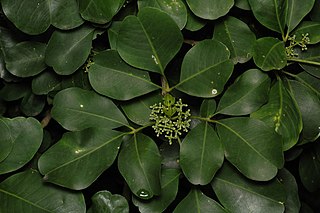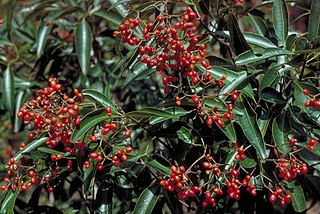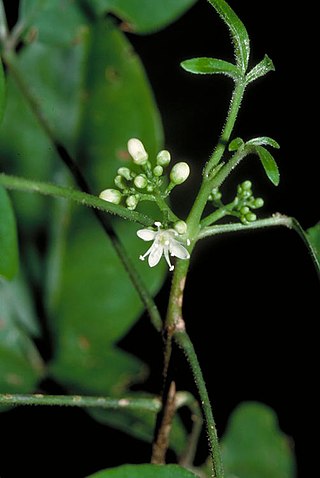
Melicope elleryana, commonly known as pink flowered doughwood, pink evodia, corkwood, or saruwa, is a species of rainforest shrub or tree in the family Rutaceae, and is native to New Guinea, parts of eastern Indonesia, the Solomon Islands and northern Australia. It has trifoliate leaves and pink to white, bisexual flowers arranged in panicles in leaf axils.

Melicope micrococca, commonly known as hairy-leaved doughwood or white euodia, is a species of shrub or slender tree in the family Rutaceae and is endemic to eastern Australia. It has trifoliate leaves and white flowers borne in panicles in leaf axils.

Sarcomelicope simplicifolia, commonly known as bauerella, hard aspen or yellow-wood, is a species of flowering plant in the family Rutaceae and is endemic to eastern Australia including Lord Howe and Norfolk Islands. It is a shrub or small tree with elliptic to egg-shaped leaves arranged in opposite pairs, male or female flowers arranged in small groups in leaf axils and fruit an oval to spherical drupe.
Dendrobium macropus, commonly known as the Norfolk Island cane orchid, is a species of epiphytic or lithophytic orchid in the family Orchidaceae and is endemic to Norfolk Island. It has cylindrical pseudobulbs, thin, dark green leaves and between five and ten yellowish green flowers that do not open widely.
Dendrobium brachypus, commonly known as the dwarf cane orchid, is an epiphytic or lithophytic orchid in the family Orchidaceae. It has crowded, yellowish green pseudobulbs, dark green leaves and two or three cream-coloured to whitish or greenish flowers which often do not open fully. It grows on trees and rocks on one mountain on Norfolk Island.
Melicope contermina is a species of shrub or small tree in the family Rutaceae and is endemic to Lord Howe Island. It has trifoliate leaves and white flowers borne in leaf axils in panicles of nine to fifteen flowers.

Melicope polybotrya is a species of shrub or small tree in the family Rutaceae and is endemic to Lord Howe Island. It has trifoliate leaves and green flowers borne in short panicles in leaf axils.

Melicope bonwickii, commonly known as the yellow evodia or yellow corkwood, is a species of tree in the family Rutaceae and is native to Java and the Philippines, and southward to New Guinea and north-eastern Australia. It has trifoliate leaves and small pink flowers borne in panicles in leaf axils.

Phreatia limenophylax, commonly known as the Norfolk Island caterpillar orchid is a plant in the orchid family, an epiphyte with four to six fleshy, channelled leaves in a fan-like arrangement. A large number of tiny white flowers are arranged along a thin flowering stem. It grows on the Solomon Islands, Norfolk Island and other islands of the southwest Pacific Ocean.

Acronychia acronychioides, commonly known as white aspen, is a species of small to medium-sized rainforest tree that is endemic to north-eastern Queensland. It has trifoliate leaves with elliptic to egg-shaped leaflets on stems that are more or less cylindrical, creamy yellow flowers in large groups in leaf axils and fleshy, pear-shaped or spherical fruit.

Dinosperma is a genus of plant containing the single species Dinosperma erythrococcum, commonly known as tingletongue, clubwood or nutmeg, and is endemic to north-eastern Australia. It is a tree usually with trifoliate leaves arranged in opposite pairs, the leaflets lance-shaped to oblong, and panicles of small white flowers, later bright orange to red, slightly fleshy follicles containing shiny, bluish black seeds.
Melicope affinis is a species of shrub or tree in the family Rutaceae and is endemic to Queensland. It has trifoliate leaves and small greenish white flowers borne in panicles in leaf axils.

Melicope broadbentiana, commonly known as false euodia, is a species of shrub or tree in the family Rutaceae and is endemic to Queensland. It has simple leaves, trifoliate leaves or both, and small white flowers borne in short panicles in leaf axils.
Melicope fellii is a species of tree in the family Rutaceae and is endemic to Queensland. It has trifoliate leaves and pink flowers borne in short panicles in leaf axils.
Melicope hayesii, commonly known as small-leaved doughwood, is a species of shrub or slender tree in the family Rutaceae and is endemic to eastern Australia. It has trifoliate leaves and small white flowers borne in panicles in leaf axils.

Melicope jonesii is a species of tree in the family Rutaceae and is endemic to north-east Queensland. It has trifoliate leaves and greenish or cream-coloured flowers borne in short panicles in leaf axils.
Melicope peninsularis is a species of small tree in the family Rutaceae and is endemic to tropical north Queensland. It has trifoliate leaves and white flowers borne in short panicles in leaf axils.

Melicope rubra, commonly known as the little evodia, is a species of small tree in the citrus family Rutaceae, native to New Guinea and northeast Queensland. It was originally described as Euodia rubra in 1900. It has trifoliate leaves and pink bisexual flowers arranged on branches below the leaves.

Melicope vitiflora, commonly known as northern evodia, fishpoison wood, leatherjacket or leatherwood, is a species of shrub or small tree in the family Rutaceae and is native to north-eastern Australia and New Guinea. It has trifoliate leaves and green to white or cream-coloured flowers borne in panicles in leaf axils.

Melicope xanthoxyloides is a species of small tree in the family Rutaceae and is native to New Guinea and Queensland. It has trifoliate leaves and small green to yellow or cream-coloured flowers arranged in panicles in leaf axils.













